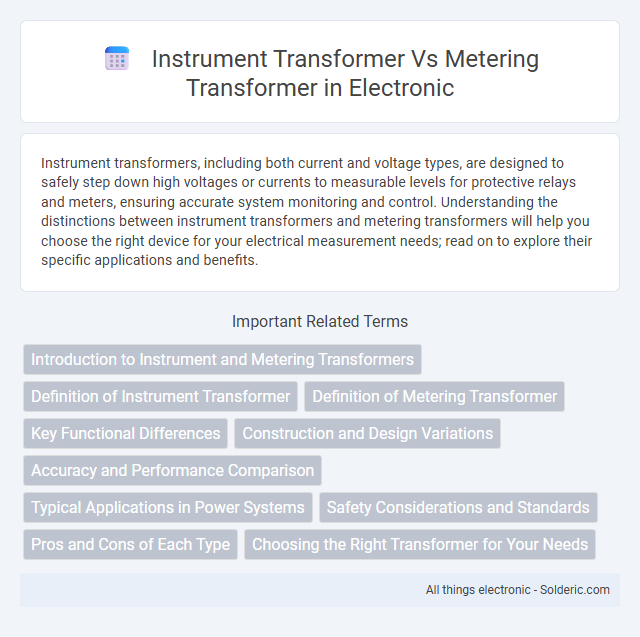Instrument transformers, including both current and voltage types, are designed to safely step down high voltages or currents to measurable levels for protective relays and meters, ensuring accurate system monitoring and control. Understanding the distinctions between instrument transformers and metering transformers will help you choose the right device for your electrical measurement needs; read on to explore their specific applications and benefits.
Comparison Table
| Feature | Instrument Transformer | Metering Transformer |
|---|---|---|
| Primary Purpose | Measurement & protection of electrical circuits | Accurate energy measurement for billing |
| Types | Current Transformer (CT), Potential Transformer (PT/VT) | Metering Current Transformer, Metering Voltage Transformer |
| Accuracy | Moderate accuracy; optimized for protective relay operation | High accuracy; complies with billing standards (IEC 61869-2) |
| Burden | Designed for lower burden (protection devices) | Designed for specific, low burden of meters |
| Output Ratio | Standard ratios tailored for relay and protection circuits | Precise ratios ensuring accurate energy measurement |
| Construction | Robust for fault conditions and transient currents | Designed to minimize measurement error and distortion |
| Standards | IEC 61869-3 (for protective CTs) | IEC 61869-2 (for metering transformers) |
| Applications | Protection relays, circuit breakers, fault detection | Electricity meters, billing, energy auditing |
Introduction to Instrument and Metering Transformers
Instrument transformers, including current transformers (CTs) and potential transformers (PTs), are essential devices for measuring high voltage and current in electrical power systems safely and accurately. Metering transformers, a subset of instrument transformers, are specifically designed for precise energy measurement and billing purposes, ensuring reliable data for your electrical consumption. Understanding the distinctions between these transformers helps optimize system protection, control, and metering efficiency in power distribution networks.
Definition of Instrument Transformer
An instrument transformer is a device used to accurately transform high voltage or current values to standardized, manageable levels for measurement and protection in electrical systems. Metering transformers, a subset of instrument transformers, specifically provide precise scaling for energy metering and billing purposes. Instrument transformers include current transformers (CTs) and voltage transformers (VTs), designed to ensure safety and maintain accuracy during electrical measurements.
Definition of Metering Transformer
A metering transformer is a type of instrument transformer designed specifically to provide accurate voltage or current measurement for metering purposes in electrical power systems. It steps down high voltages or currents to standardized, safer levels for precise energy measurement and monitoring by your metering devices. Unlike general instrument transformers, metering transformers prioritize accuracy and minimal phase displacement to ensure reliable billing and system analysis.
Key Functional Differences
Instrument transformers primarily serve to step down high voltages or currents to standardized, safe levels for measurement and protection devices, ensuring system safety and accuracy. Metering transformers, a subset of instrument transformers, are specifically designed to provide precise signals for billing purposes, emphasizing accuracy over a defined range of load conditions. Your choice between these transformers depends on whether the application prioritizes operational protection or revenue metering requirements.
Construction and Design Variations
Instrument transformers, including current transformers (CTs) and voltage transformers (VTs), are designed with robust insulation, precise winding ratios, and standardized construction for protection and measurement in high-voltage environments. Metering transformers, a subset of instrument transformers, emphasize accuracy and stability with specially designed low-loss cores and tight tolerance windings to ensure precise energy measurement. Construction variations between them primarily involve core materials, accuracy classes, and thermal ratings tailored to their specific application requirements in power systems.
Accuracy and Performance Comparison
Instrument transformers, including current and voltage transformers, provide high accuracy for protection and control applications, typically within 0.1% to 1% error range, ensuring reliable performance under varying load conditions. Metering transformers, designed specifically for billing and measurement, prioritize precision with accuracy classes like 0.1, 0.2, and 0.5, maintaining stable performance and minimal phase displacement to ensure precise energy metering. Overall, metering transformers exhibit superior accuracy and lower total harmonic distortion compared to general instrument transformers, optimizing performance for billing accuracy and regulatory compliance.
Typical Applications in Power Systems
Instrument transformers are primarily used in power systems for protective relaying and control, providing accurate voltage and current measurements to ensure system safety and stability. Metering transformers, such as current and voltage transformers, are designed specifically for precise energy measurement and billing purposes in utility substations and industrial facilities. Your choice between the two depends on whether the application prioritizes protection accuracy or metering accuracy in power system management.
Safety Considerations and Standards
Instrument transformers and metering transformers both play crucial roles in electrical systems, but safety considerations differ significantly due to their functions and standards compliance. Instrument transformers, used for protection and control, must meet stringent standards such as IEC 61869 to ensure accurate signal transmission without compromising system safety during high fault currents. Metering transformers prioritize precise energy measurement, adhering to strict accuracy classes under standards like IEC 60044-1, with safety features designed to prevent hazardous overloads and ensure reliable billing data.
Pros and Cons of Each Type
Instrument transformers offer high accuracy and isolation for protective relays but can be costly and require regular maintenance due to their complexity. Metering transformers provide reliable energy measurement with simpler construction and lower cost but may have lower accuracy under varying load conditions. Selecting between the two depends on prioritizing precision and durability for protection or cost-efficiency and straightforward metering.
Choosing the Right Transformer for Your Needs
Selecting the right transformer for your needs depends on understanding the distinction between instrument transformers and metering transformers. Instrument transformers are designed primarily for protection and control by accurately stepping down high voltages or currents to measurable levels, ensuring safety and precision in monitoring electrical systems. Metering transformers focus on delivering precise measurements for billing and energy management, emphasizing accuracy and reliability under varying load conditions.
instrument transformer vs metering transformer Infographic

 solderic.com
solderic.com